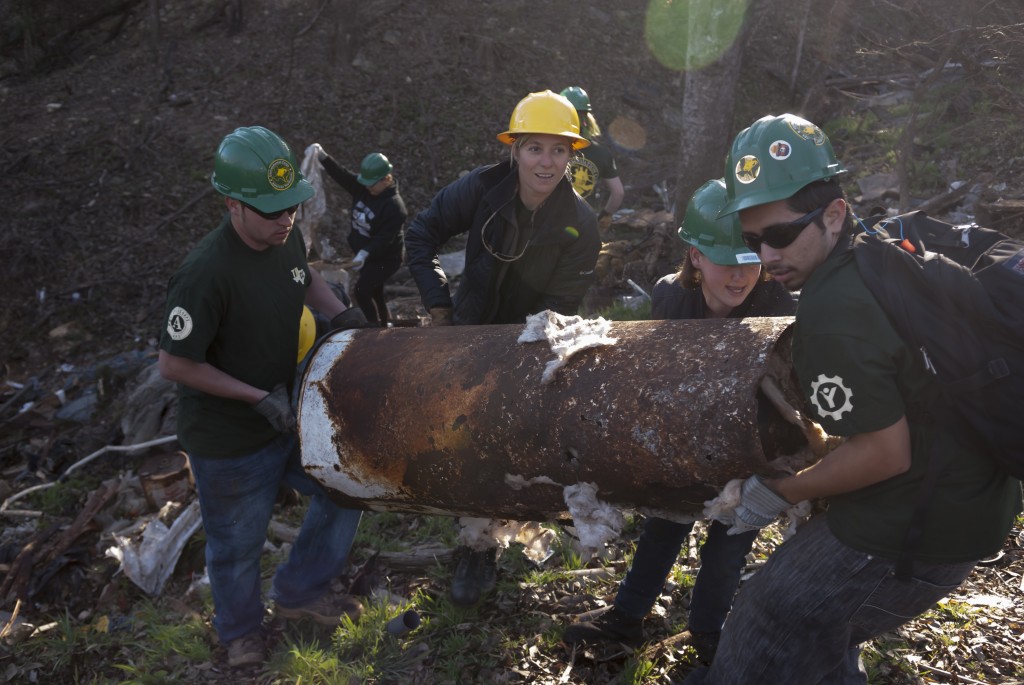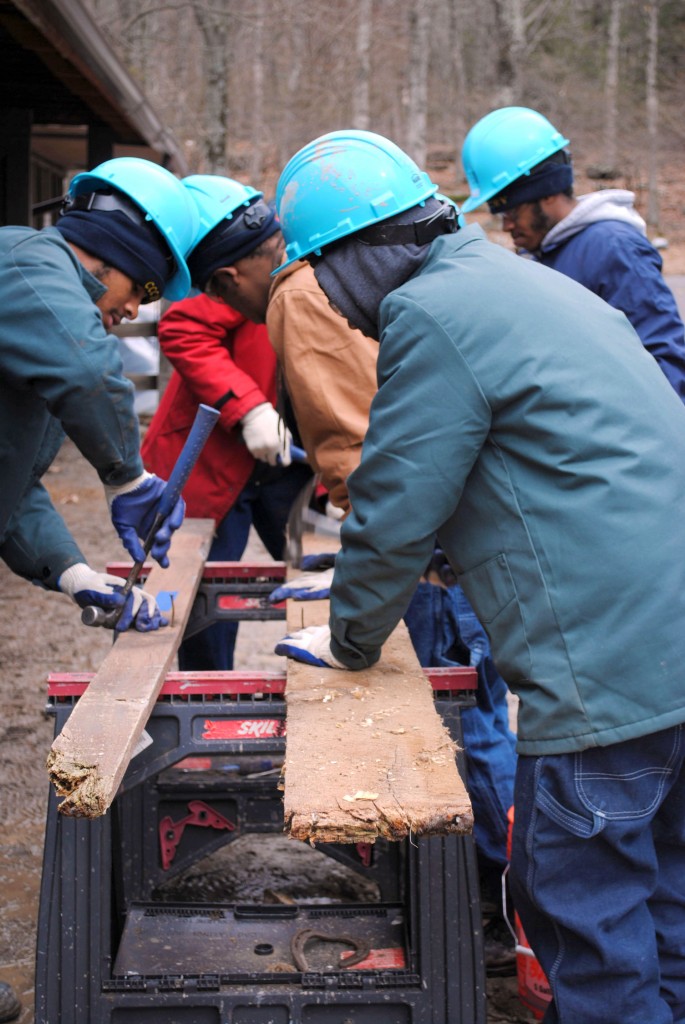Click on the image below to see the timeline of 21CSC activities building up to today.


Last week, Groundwork Cincinnati-Mill Creek youth worked alongside Bill Scripp, a Recreation Technician from the Athens Ranger District on the Wayne National Forest in southeast Ohio. In this picture, youth are learning how to build a footbridge at Utah Pond near Nelsonville, Ohio.
This story and photos provided by the U.S. Forest Service.
In support of the 21st Century Conservation Service Corps (21CSC), the Wayne National Forest and Groundwork Cincinnati-Mill Creek, a nonprofit organization is one of several organization across the nation selected as an important partner in standing up the 21CSC, a collaborative effort to put America’s youth and veterans to work protecting, restoring and enhancing America’s great outdoors.
The partnership includes multiple opportunities over the next several months for Wayne National Forest employees to connect with young people on the Forest and at Groundwork Cincinnati-Mill Creek. Several young people are accomplishing meaningful work, and gaining important personal and professional skills, while building a lifelong connection to the outdoors.
Originally published on nationalservice.gov
For decades, national service has been a cost-effective solution to critical challenges facing our communities and nation. Recognizing the value of national service in improving lives and strengthening communities, President Obama created the Task Force on Expanding National Service in July 2013 to expand national service to meet national needs through collaboration with other Federal agencies and the private sector.
In July 2014, USDA and CNCS announced a landmark new partnership between AmeriCorps and the USDA’s Forest Service that connects youth and veterans with service opportunities to restore the nation’s forests and grasslands. The $3.8 million in joint funding will provide resources for both AmeriCorps grantees and member organizations of the 21st Century Conservation Service Corps (21CSC), and will also provide for 300 new AmeriCorps members serving in U.S. forests and grasslands.
AmeriCorps is part of a long American tradition of conservation service that dates back to the Civilian Conservation Corps and builds on the large network of state and local conservation corps that have emerged over the past four decades.
Through the President’s Task Force on Expanding National Service, CNCS is working with USDA and other federal agencies and nonprofit partners to create a 21st Century Conservation Service Corps, a national collaborative effort to put America’s youth and returning veterans to work protecting, restoring and enhancing America’s great outdoors.
Through this new partnership, AmeriCorps members and other youth will restore the nation’s forests and grasslands, meeting critical environmental needs as they gain valuable skills and college support to jumpstart their careers.
Each week the Partnership for the 21st Century Conservation Service Corps will use this blog to feature the project of the week for ten weeks as we lead up to announce the full “100 Featured Projects for the 21CSC.” Below you will find the projects of the week with the most recent at the top of the page.
With a grant through the Ecosystem Restoration Program, the Vermont Department of Environmental Conservation has provided funding to support the Vermont Youth Conservation Corps (VYCC) as part of the 21st Century Service Conservation Corps to complete 11 weeks of water quality improvement projects throughout the state of Vermont during 2014. The VYCC provides employment, training and education to young people ages 16-24 through the completion of high priority conservation projects around the state.
Phosphorus is one of Vermont’s greatest water quality challenges. In Lake Champlain, phosphorus, combined with sediment, feeds toxic algae blooms, particularly in shallow sections of the Lake such as Missisquoi Bay, Saint Albans Bay, and the South Lake region. These toxic blooms negatively impact public health, recreation, and our immediate enjoyment of the lake.
In 2014, as part of a multi-state, international effort to reduce the amount of phosphorous in Lake Champlain, the VYCC as part of the 21st Century Service Conservation Corps will field crews to complete water quality improvement projects including river and lake shoreline stabilization, planting of native trees to create riparian buffers, and the installation of engineered stone structures to help dissipate erosive forces in storm water impacted streams. Projects have been developed in partnership with the Connecticut River Watershed Alliance, the White River Partnership, The Black River Action Team, the Lake Iroquois Association, the Winooski Natural Resource Conservation District, and the Vermont Lakewise Program.
Urban Corps of San Diego County has partnered with the City of San Diego to implement a $1.08 million park improvement project at the celebrated Chicano Park in the Barrio Logan neighborhood of San Diego. The park —listed on the National Register of Historic Places— is San Diego County Regional Park best known as an outdoor mural museum documenting Chicano history in colorful imagery. Chicano Park was developed after a month-long protest in 1970 by Chicano activists, when plans for the park were nearly set aside to make way for a California Highway Patrol station.
The Chicano Park Improvement Project is being made possible by a grant from the California Department of Housing and Community Development and charges Urban Corps with outreach, planning, design and build-out of a variety of enhancements. The project will result in much-needed safety improvements, recreational opportunities, and a more vibrant public park while helping disadvantaged young adults in the Urban Corps program succeed in San Diego’s 21st century workforce. At least 20 Corpsmembers will gain valuable construction and landscaping job skills while studying at Urban Corps Charter School to obtain their high school diplomas.

Texas Conservation Corps providing disaster relief at Gulf Coast as part of 21st Century Conservation Service Corps
As a recent crew of young people pushed through a riparian forest at the Trinity River National Wildlife Refuge removing Chinese Tallow and other invasive species, they also stood ready to respond to disaster. Their team, part of a total of 50 Corps members from the Texas Conservation Corps who have signed up for a year of national service in the fields of conservation and disaster response, are trained and ready to be deployed across the region with limited notice.
This past winter, Corps members spent over one month training in disaster response and conservation skills. When the next disaster strikes the teams are ready within 24 hours to integrate into the existing structure of an emergency operation’s Incident Command System. The team’s disaster response skills include hazardous debris removal, home repair and shelter management with a specialization in volunteer management. Their conservation work often has an emergency management aspect as well, with hazard fuel mitigation projects protecting communities from wildfire and habitat restoration work that increases the ability of local ecosystems to withstand natural disasters.
Last October, The Student Conservation Association (SCA), a member of the 21st Century Conservation Service Corps, launched the ConSERVE NYC initiative on the anniversary of Hurricane Sandy. The initiative has already rallied over 650 volunteers to enhance the storm resiliency of New York City’s public lands. As summer approaches, the volunteer momentum builds.
ConSERVE NYC brings together SCA members, partners and alumni, as well as students and members of the public to participate in large-scale weekend service events at locations around the city. After seven months, ConSERVE has touched all five boroughs of NYC. Volunteers have built erosion control fencing at Great Kills Park in Staten Island, planted flower bulbs at Riverside Park in Manhattan, improved trails at Van Cortlandt Park in the Bronx, mulched beds at Morningside Park in Manhattan, cleared debris from the beaches at Jamaica Bay Wildlife Refuge in Queens, and removed invasive ivy from the Brooklyn Greenway. In celebration of Earth Day, 150 volunteers gathered at Hudson River Park in April to plant native shrubs.

Five HOPE Crew members work to preserve historic fabric of Skyland Stables at Shenandoah National Park.
The Skyland Stable, constructed in 1939, is located in Shenandoah National Park and is a contributing structure to the Skyline Drive National Historic Landmark District. The stables are owned by the National Park Service and managed by Delaware North Companies, the park concessionaire, who operates the stables to provide trail rides for visitors to the park.
To repair damage caused by water infiltration, ten Corpsmembers of the Citizens Conservation Corps of West Virginia, in partnership with Harpers Ferry Job Corps, completed a nine-week preservation carpentry project to rehabilitate the exterior of the stable. With the guidance of a craft expert and preservation advisor, the HOPE Crew was able to identify and replace deteriorated wooden planks, repair damaged doors, apply stain to the structure, and save a historic structure that would have otherwise been forced out of service.
The stables are now fully operational, and the 1.2 million visitors to Shenandoah National Park can continue to rent horses and utilize the 200 miles of equestrian trails.
Conservation Corps youth take a break after a day of pulling buckthorn on National Park Service lands along the St. Croix National Scenic Riverway, east of Saint Paul, Minnesota.
Editor’s Note: This week Secretary of the Interior Sally Jewell and National Park Service Director Jonathan Jarvis visited St. Paul Minnesota to sign an agreement with the National League of Cities and the YMCA to better coordinate efforts to get kids outdoors, as part of the Secretary’s youth initiative. This week we will highlight the additional efforts of an organization supporting the Secretary’s goals for her initiative in the Twin Cities area through the 21st Century Conservation Service Corps.
This summer, youth will play in vital role in helping to protect biodiversity and improve visitors’ experience along the St. Croix National Scenic Riverway. The St. Croix River, with its proximity to the Twin Cities metropolitan area and federal designation as a Wild and Scenic River, is a popular outdoor recreation area for paddling, hiking, biking and birdwatching. Participants, ages 15-18, and young adult AmeriCorps members will work in crews of eight, along shoreline and public lands in this national park to remove invasive buckthorn and purple loosestrife that destroy native vegetation and critical habitat. Corpsmembers will also be involved with identifying and mapping threatened areas.
The St. Croix projects will engage a total of 60 diverse youth participants from Conservation Corps Minnesota & Iowa, a 21st Century Conservation Service Corps program operator, in partnership with the National Park Service. The projects will be completed over eight weeks of the 2014 the Summer Youth Corps program.